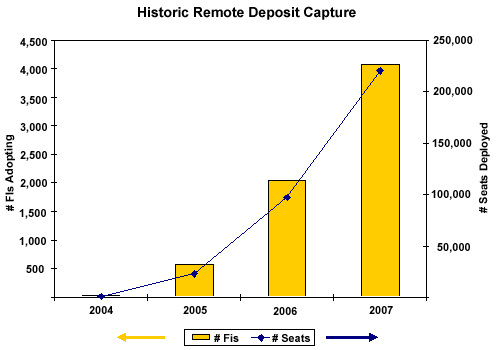State of Remote Deposit Capture: Entering the Mainstream
Abstract
Over a third of US financial institutions already offer remote deposit capture services, and nearly one-half will do so by year end, but adoption by clients has a long way to go.
Few topics in banking have enjoyed such hype as remote deposit capture (RDC), and rightly so. Unintentionally, perhaps, Check 21 acted as a catalyst not only for image-based check processing but also for fundamental changes to the way deposits would be made, and arguably altering the competitive landscape in ways no other innovation has done.
Among financial institutions, RDC adoption has been astonishing--even faster than the Internet banking gold rush. In just two years, nearly a third of all US banks have adopted RDC solutions. Over 2,900 financial institutions have implemented (or are implementing) RDC through March 2007, corresponding to some 112,000 scanners. Based on aggregate vendor activity, Celent expects over 4,000 institutions will have solutions deploying nearly 250,000 devices by year end 2007. But it's not just about checks. The four largest cash logistics providers (representing 70% of the US market) have installed check imaging in their cash vault networks to strengthen banks' abilities to capture mixed deposits beyond their historic footprint.

But for all the activity involving bank adoption, client-level adoption has been unimpressive. Less than 2% of businesses have signed up for RDC. This has not been a result of lack of demand, but rather banks' slowness to action and fixation on theoretical risks involved with RDC. Companies have adopted solutions offered by vendors rather than by banks. This direct adoption will deconstruct banks' ownership of the RDC value chain and leave them competing for low-margin image cash letter deposits, much like they do for ACH origination services. Client-level adoption is gaining momentum and will continue to do so over the next several years as competition grows. In the next two years, clients will near the 1 million mark; by 2012, clients will swell to over 5 million.
"Many banks are still just getting started with remote deposit capture, and haven't seen the growing competition for clients that is quickly emerging," says Bob Meara, author of the report and senior analyst in the Banking group at Celent. "The next 12 months will be telling, as the majority of institutions with defensive postures feel the heat from relatively few aggressive remote deposit deployers willing to make an investment in core deposit growth."
The 46-page report contains 20 figures and 10 tables. A table of contents is available online. Members of Celent's Wholesale Banking research services can download the report electronically by clicking on the icon to the left. Non-members should contact info@celent.com for more information.

